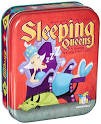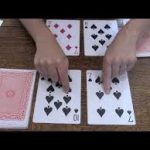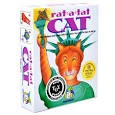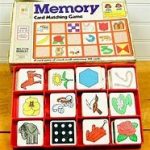From Misery to Magic: Building the Young Math Brain in Everyday Life
posted by Kate O’Donnell
 Math really is fun. It can be misery trying to teach it, but magic when you integrate it into your child’s everyday life.
Math really is fun. It can be misery trying to teach it, but magic when you integrate it into your child’s everyday life.
It’s a mystery to me why some children have a natural affinity for numbers while others show no interest or may even resist them. It may be no different than why I chose to participate in gymnastics as a child while my best friend’s sport of choice was soccer. We veer toward subjects and activities that come easily and steer away from those that are confusing or tricky. As a parent of four young children and a learning specialist, I know how difficult it can be to get a child to participate in something they think is hard or boring. Pushing concepts on young children will prove arduous to both the adult and child, so what are some fun ways parents and educators can engage young children with math?
Too often we turn to the computer for answers, . Or the apps on a smartphone. While some of these are fun, my children already spend enough time in front of screens. There are many workbooks that reinforce math concepts, but if your children are like mine, they aren’t going to be motivated by more ditto sheets. Instead, I propose thinking more organically about numbers and mathematical concepts; they are hiding within so much of what we do everyday. Very often, we can explore mathematical language and concepts without it ever seeming to our children that we are “working on math”. If there are two words that don’t go over well with children, the top two might be “work” and “math”.
Some examples of how to bring math into everyday life:
*Put a timer on the microwave. Tell your child how much time you’ve put on the timer. Challenge them to pick up their toys or clean their room before the timer beeps. If they finish early, do a countdown with them while watching the numbers on the clock. You could even hold up fingers for the 10, 9, 8, 7, 6, 5, 4, 3, 2, 1 countdown. If it was not enough time, talk about how much MORE time could have been added to the timer. If it was too much time, how much LESS could have been used.
*Have your child study their cereal box in the morning. Any aged child loves to look at the colors, the characters, and the games or stories on the back of the box. But cereal offers many other rich math opportunities:
-Talk about the numbers they see in the ingredients. Discuss which character on the box is “bigger” than another. Take the cereal box apart, cut the pieces and measure them with a ruler or just lay them next to one another and decide which is taller and which is shorter.
-Pull a handful of cereal out and count. How many “marshmallows” are in the cereal (if you like the junk cereal variety)? Separate by color. Sort piles of like shapes. The amount of opportunities to get the math brain curious is limitless.
*Near your child’s bed, create a Mathematical bulletin board. My youngest son sleeps on the bottom bunk in a bunk bed. I created a beautiful (not too visual so as to keep him awake) collage of mathematical concepts for him to peek at before he closed his eyes at night.
After we read, I count with him. We find numbers. We look to see which number is “bigger”. We play riddle games. “I’m thinking of a number”. When he is tired, I never force it. When things get old, I switch it up. It is fun because he never knows what is going to be on the board next.
*Is your child physical? Make movement mathematical. How many times can you throw the ball back and forth or roll it if catch proves difficult. Create a dart board (out of plain paper) with numbers on it. Make paper airplanes and see what numbers you can both hit.
Get a jump rope and sing a number song or count. Kick a soccer ball and keep tally marks on a sheet of paper to track how many goals are made by each player.
*Cook and bake with your child. Both offer very rich opportunities to sneak numbers in. There are fraction opportunities but also looking at temperature on an oven. Talking about how long the item needs to cook. How many minutes does the batter need to be mixed? Etc.
*Play games. Dice games, card games, matching games. There are a plethora of board games that include mathematical concepts.

-Sleeping Queens (A family favorite- enjoyed from my 5 year old up through both parents!)
-War: an easy way to compare numbers. You can add and have each player turn over two cards. The bigger number after you’ve added keeps all 4 cards.

-Rat a Tat Cat (Another family favorite that involves your wanting to keep the “low” numbers and get rid of the “high” ones)
-Shut the Box: Roll the dice and close the doors on the numbers you roll. Try to “shut all of the numbers” to end with the lowest number.

-Memory: Who could forget Memory? What a wonderful game. The cards can have shapes on them or numbers. While playing and matching, talk about the shapes they see, count the images on the card together before making matches.

These ideas are not new and this list is far from complete- there are so many more hidden opportunities to learn math. They are things that many parents are already doing with their children everyday. However, when it is not obvious that Math is being taught, it can be easy to overlook the Math hidden right in front of you. Before you turn on a computer or buy a workbook, try to find the hidden math in your everyday life. To insert mathematical language, concepts and games into their life can make all of the difference. After working in a few more of these ideas, I think you’ll see your child building a math brain from everyday life.
 Math really is fun. It can be misery trying to teach it, but magic when you integrate it into your child’s everyday life.
Math really is fun. It can be misery trying to teach it, but magic when you integrate it into your child’s everyday life.
Great ideas, Kate! We are always on the look out for new games to play! Thanks for sharing!
i like all the ideas for everyday learning built into your routines
Great ideas for math activities at home. Thanks for sharing.
I will definitely use these ideas!
Great ideas! I like the board game suggestions since my own children are no longer young I have not seen some of those games! I like the collage by the bed idea- I always had one for ABCs and literature and a number line but didn’t extend beyond that. I look forward to sharing some of these suggestions!